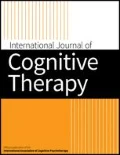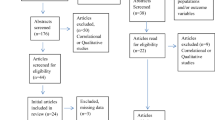Abstract
The cognitive attentional syndrome (CAS) is characterized by threat monitoring, repetitive thinking, limitation in cognitive resources, unhelpful control strategies, and continued focus on the content of thinking (Wells 2000, 2002, 2006; Wells & Matthews in Cognition & Emotion, 8(3), 279-295, 1994). An alternative model of worry—the avoidance theory—proposes that worry is reinforced by the temporary decrease in arousal during the activation of “cognitive” or abstract worry (Borkovec et al. 2004; Borkovec and Inz in Behaviour Research and Therapy, 28(2), 153-158, 1990). The current study proposed that metacognitive processes are more likely to be activated if individuals have negative beliefs about emotional experience. Four hundred twenty-five participants completed the Metacognition Questionnaire (MCQ), Leahy Emotional Schema Scale (Leahy in Cognitive and Behavioral Practice, 9(3), 177-190, 2002), BDI-II, and the BAI. Negative beliefs about emotions were significantly correlated with each of the five metacognitive factors and with both depression (BDI-II) and anxiety (BAI). Almost all of the 14 emotional schema dimensions were related to the five metacognitive factors of worry. Mediational analyses suggested that uncontrollability/danger of worry partially mediated the relationship between negative beliefs about emotion and symptoms of anxiety. Similarly, uncontrollability/danger of worry and cognitive competence/confidence partially mediated the relationship between negative beliefs about emotion and symptoms of depression. These findings support metacognitive, avoidance, and emotional schema models by indicating that both metacognitive processes and beliefs about emotion separately contribute to depression and anxiety and that worry appears to be a strategy that is utilized to cope with negative beliefs about emotion.


Similar content being viewed by others
References
Beck, A. T., Epstein, N., Brown, G., & Steer, R. A. (1988). An inventory for measuring clinical anxiety: psychometric properties. Journal of Consulting and Clinical Psychology, 56(6), 893.
Beck, A. T., Steer, R. A., & Brown, G. (1996). Manual for the Beck Depression Inventory-II. San Antonio: The Psychological Corporation.
Borkevec, T. D., & Sharpless, B. (2004). Generalized anxiety disorder: bringing cognitive behavioral therapy into the valued present. In S. C. Hayes, V. M. Follette, & M. M. Linehan (Eds.), Mindfulness and acceptance: expanding the cognitive-behavioral tradition (pp. 209–242). New York: Guilford.
Borkovec, T. D. (1994). The nature, functions, and origins of worry. In G. Davey & F. Tallis (Eds.), Worrying: perspectives on theory, assessment and treatment (pp. 5–33). Oxford: John Wiley & Sons.
Borkovec, T. D., & Hu, S. (1990). The effect of worry on cardiovascular response to phobic imagery. Behaviour Research and Therapy, 28(1), 69–73.
Borkovec, T. D., & Inz, J. (1990). The nature of worry in generalized anxiety disorder: a predominance of thought activity. Behaviour Research and Therapy, 28(2), 153–158.
Borkovec, T.D., & Sharpless, B. (2004). Generalized Anxiety Disorder: Bringing Cognitive Behavioral Therapy into the Valued Present. In S. Hayes, V. Follette, & M. Linehan (Eds.), New directions in behavior therapy, (pp. 209–242). New York, NY: Guildford.
Borkovec, T. D., & Sides, J. K. (1979). The contribution of relaxation and expectancy to fear reduction via graded, imaginal exposure to feared stimuli. Behaviour Research and Therapy, 17(6), 529–540.
Borkovec, T. D., Alcaine, O., & Behar, E. (2004). Avoidance theory of worry and generalized anxiety disorder. In R. G. Heimberg, C. L. Turk, & D. S. Mennin (Eds.), Generalized anxiety disorder: advances in research and practice (pp. 77–108). New York: Guilford Press.
Cartwright-Hatton, S., & Wells, A. (1997). Beliefs about worry and intrusions: the Meta-Cognitions Questionnaire and its correlates. Journal of Anxiety Disorders, 11(3), 279–296.
Dragan, M., Dragan, W. Ł., Kononowicz, T., & Wells, A. (2012). On the relationship between temperament, metacognition, and anxiety: independent and mediated effects. Anxiety, Stress, and Coping, 25(6), 697–709.
Edwards, E. & Wupperman, P. (2018). Research on emotional schemas: A review of findings and challenges. Clinical Psychologist. Advance online publication. https://doi.org/10.1111/cp.12171
Edwards, E. R., Micek, A., Mottarella, K., & Wupperman, P. (2017). Emotion ideology mediates effects of risk factors on alexithymia development. Journal of Rational-Emotive & Cognitive-Behavior Therapy, 35(3), 254–277.
Hayes, A. (2017) Introduction to mediation, moderation, and conditional process analysis, Second Edition: A regression-based approach (Methodology in the Social Sciences) Second Edition Guilford: New York.
Hayes, S. C., Wilson, K. G., Gifford, E. V., Follette, V. M., & Strosahl, K. (1996). Experiential avoidance and behavioral disorders: a functional dimensional approach to diagnosis and treatment. Journal of Consulting and Clinical Psychology, 64(6), 1152.
Hayes, S. C., Levin, M. E., Plumb-Vilardaga, J., Villatte, J. L., & Pistorello, J. (2013). Acceptance and commitment therapy and contextual behavioral science: examining the progress of a distinctive model of behavioral and cognitive therapy. Behavior Therapy, 44(2), 180–198.
Hofmann, S. G., Moscovitch, D. A., Litz, B. T., Kim, H. J., Davis, L. L., & Pizzagalli, D. A. (2005). The worried mind: autonomic and prefrontal activation during worrying. Emotion, 5(4), 464.
Holeva, V., Tarrier, N., & Wells, A. (2001). Prevalence and predictors of acute stress disorder and PTSD following road traffic accidents: thought control strategies and social support. Behavior Therapy, 32(1), 65–83.
Khaleghi, M., Leahy, R. L., Akbari, E., Mohammadkhani, S., Hasani, J., & Tayyebi, A. (2017). Emotional schema therapy for generalized anxiety disorder: a single-subject design. International Journal of Cognitive Therapy, 10(4), 269–282.
Leahy, R. L. (2002). A model of emotional schemas. Cognitive and Behavioral Practice, 9(3), 177–190.
Leahy, R. L. (2015). Emotional schema therapy. New York: Guilford.
Leahy, R. L. (2018). Emotional schema therapy: distinctive features. London: Routledge.
Leahy, R. L., Tirch, D. D., & Melwani, P. S. (2012). Processes underlying depression: risk aversion, emotional schemas, and psychological flexibility. International Journal of Cognitive Therapy, 5(4), 362–379.
Llera, S. J., & Newman, M. G. (2010). Effects of worry on physiological and subjective reactivity to emotional stimuli in generalized anxiety disorder and nonanxious control participants. Emotion, 10(5), 640.
Llera, S. J., & Newman, M. G. (2014). Rethinking the role of worry in generalized anxiety disorder: evidence supporting a model of emotional contrast avoidance. Behavior Therapy, 45(3), 283–299.
Mennin, D. S., & Fresco, D. M. (2014). Emotion regulation therapy. Handbook of Emotion Regulation, 2, 469–490.
Mennin, D. S., Heimberg, R. G., Turk, C. L., & Fresco, D. M. (2002). Applying an emotion regulation framework to integrative approaches to generalized anxiety disorder. Clinical Psychology: Science and Practice, 9(1), 85–90.
Mennin, D. S., Heimberg, R. G., Turk, C. L., & Fresco, D. M. (2005). Preliminary evidence for an emotion dysregulation model of generalized anxiety disorder. Behaviour Research and Therapy, 43(10), 1281–1310.
Morvaridi, M., Mashhadi, A., Shamloo, Z. S. (2018). The Effectiveness of Group Emotional Schema Therapy on Emotional Regulation and Social Anxiety Symptoms. International Journal of Cognitive Therapy.
Newman, M. G., & Llera, S. J. (2011). A novel theory of experiential avoidance in generalized anxiety disorder: a review and synthesis of research supporting a contrast avoidance model of worry. Clinical Psychology Review, 31(3), 371–382.
Nolen-Hoeksema, S. (1991). Responses to depression and their effects on the duration of depressive episodes. Journal of Abnormal Psychology, 100(4), 569–582.
Nolen-Hoeksema, S. (2000). The role of rumination in depressive disorders and mixed anxiety/depressive symptoms. Journal of Abnormal Psychology, 109(3), 504.
Nolen-Hoeksema, S., Parker, L. E., & Larson, J. (1994). Ruminative coping with depressed mood following loss. Journal of Personality and Social Psychology, 67(1), 92.
Papageorgiou, C., & Wells, A. (2001a). Metacognitive beliefs about rumination in recurrent major depression. Cognitive and Behavioral Practice, 8(2), 160–164.
Papageorgiou, C., & Wells, A. (2001b). Positive beliefs about depressive rumination: development and preliminary validation of a self-report scale. Behavior Therapy, 32(1), 13–26.
Papageorgiou, C., & Wells, A. (2003). An empirical test of a clinical metacognitive model of rumination and depression. Cognitive Therapy and Research, 27(3), 261–273.
Papageorgiou, C., & Wells, A. (2004). Depressive rumination: nature, theory, and treatment. New York: Wiley.
Pennebaker, J. W., & Chung, C. K. (2011). Expressive writing: connections to physical and mental health. In H. S. Friendman (Ed.), The Oxford handbook of health psychology (pp. 417–437). New York: Oxford University Press.
Rezaee, M., Ghazanfari, F., & Reazee, F. (2016). Effectiveness of emotional schema therapy on severity of depression and rumination in people with major depressive disorder. The Journal of Shahid Sadoughi University of Medical Sciences University of Medical Sciences, 24(1), 41–54.
Roussis, P., & Wells, A. (2006). Post-traumatic stress symptoms: tests of relationships with thought control strategies and beliefs as predicted by the metacognitive model. Personality and Individual Differences, 40(1), 111–122.
Silberstein, L. R., Tirch, D., Leahy, R. L., & McGinn, L. (2012). Mindfulness, psychological flexibility and emotional schemas. International Journal of Cognitive Therapy, 5(4), 406 419.
Solem, S., Håland, Å. T., Vogel, P. A., Hansen, B., & Wells, A. (2009). Change in metacognitions predicts outcome in obsessive–compulsive disorder patients undergoing treatment with exposure and response prevention. Behaviour Research and Therapy, 47(4), 301–307.
Spada, M. M., & Wells, A. (2009). A metacognitive model of problem drinking. Clinical Psychology & Psychotherapy. An International Journal of Theory & Practice, 16(5), 383–393.
Spada, M. M., Nikčević, A. V., Moneta, G. B., & Wells, A. (2008). Metacognition, perceived stress, and negative emotion. Personality and Individual Differences, 44(5), 1172–1181.
Spada, M. M., Caselli, G., & Wells, A. (2009). Metacognitions as a predictor of drinking status and level of alcohol use following CBT in problem drinkers: a prospective study. Behaviour Research and Therapy, 47(10), 882–886.
Stöber, J., & Borkovec, T. D. (2002). Reduced concreteness of worry in generalized anxiety disorder: findings from a therapy study. Cognitive Therapy and Research, 26(1), 89–96.
Tirch, D. D., Leahy, R. L., Silberstein, L. R., & Melwani, P. S. (2012). Emotional schemas, psychological flexibility, and anxiety: the role of flexible response patterns to anxious arousal. International Journal of Cognitive Therapy, 5(4), 380–391.
Turk, C. L., Heimberg, R. G., Luterek, J. A., Mennin, D. S., & Fresco, D. M. (2005). Emotion dysregulation in generalized anxiety disorder: a comparison with social anxiety disorder. Cognitive Therapy and Research, 29(1), 89–106.
Wells, A. (2000). Treating pathological worry and generalized anxiety disorder. Emotional disorders and metacognition: innovative cognitive therapy (pp. 155–178). New York: Wiley.
Wells, A. (2002). Meta-cognitive beliefs in the maintenance of worry and generalized anxiety disorder. In R. G. Heimberg, C. L. Turk, & D. S. Mennin (Eds.), Generalized anxiety disorder: advances in research and practice. New York: Guilford.
Wells, A. (2005). Worry, intrusive thoughts, and generalized anxiety disorder: The metacognitive theory and treatment. In D. A. Clark (Ed.), Intrusive thoughts in Clinical Disorders: Theory, research and treatment. New York, NY: Guildford
Wells, A., & Carter, K. (2001). Further tests of a cognitive model of generalized anxiety disorder: metacognitions and worry in GAD, panic disorder, social phobia, depression, and nonpatients. Behavior Therapy, 32(1), 85–102.
Wells, A., & Cartwright-Hatton, S. (2004). A short form of the metacognitions questionnaire: properties of the MCQ-30. Behaviour Research and Therapy, 42(4), 385–396.
Wells, A., & Matthews, G. (1994). Self-consciousness and cognitive failures as predictors of coping in stressful episodes. Cognition & Emotion, 8(3), 279–295.
Wells, A., & Papageorgiou, C. (1998). Relationships between worry, obsessive–compulsive symptoms and meta-cognitive beliefs. Behaviour Research and Therapy, 36(9), 899–913.
Westphal, M., Leahy, R. L., Pala, A. N., & Wupperman, P. (2016). Self-compassion and emotional invalidation mediate the effects of parental indifference on psychopathology. Psychiatry Research, 242, 186–191.
Author information
Authors and Affiliations
Corresponding author
Additional information
Publisher’s Note
Springer Nature remains neutral with regard to jurisdictional claims in published maps and institutional affiliations.
Rights and permissions
About this article
Cite this article
Leahy, R.L., Wupperman, P., Edwards, E. et al. Metacognition and Emotional Schemas: Effects on Depression and Anxiety. J Cogn Ther 12, 25–37 (2019). https://doi.org/10.1007/s41811-018-0035-8
Published:
Issue Date:
DOI: https://doi.org/10.1007/s41811-018-0035-8




